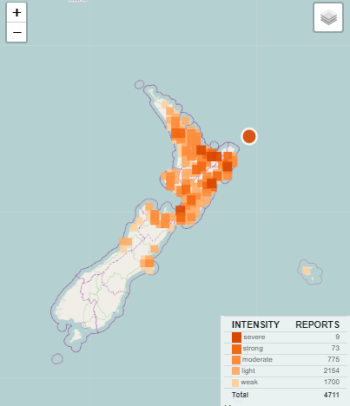
Can practice foresee reality? The uncanny timing of Exercise Tangaroa
Just over a year ago, at 4:37am on the 2nd of September 2016 people in towns along the East Cape of the North Island were woken with a rumbling jolt.
Reports came in from all over the North Island (and some from the South Island too) describing how the motion woke them - but the quake was offshore and the damage on land was minor so this event went a little under the radar for most.
The East Cape earthquake and its small tsunami occurred two days after the start of last year’s national tsunami exercise, Exercise Tangaroa. For GeoNet, the uncanny timing of the East Cape earthquake and tsunami brought home the relevance of Exercise Tangaroa, and how practising a scenario tests our interagency co-operation ahead of ‘the real deal’.
Exercise Tangaroa was run over three days – 31 August, 14 September and 28 September 2016 – and was based on the scenario of a magnitude 9.1 earthquake located in the Kermadec Islands to the northeast of New Zealand, and a consequent large tsunami.
The exercised focussed on how prepared New Zealand was to respond to a ‘regional source’ tsunami, which would reach the nearest New Zealand shores in 1-3 hours. Tangaroa was set up and run by the Ministry of Civil Defence & Emergency Management (MCDEM) but it was a multi-agency exercise that included local emergency response teams (Fire, Police and health), local Civil Defence Emergency Management Groups, local councils, and GeoNet seismologists and duty team members, among others.
For GeoNet, a regional source tsunami is one of the most complex scenarios we have to deal with. Regional source tsunamis are generated 1-3 hours away from the nearest piece of New Zealand coast – far enough away that the earthquake may not be strongly felt on land (although the shaking would be longer than a minute), but close enough that there is not much time to respond and issue a warning.
This is further complicated by the fact that offshore earthquakes are also notoriously tricky for our seismologists to locate and measure because we don’t have as many monitoring sites offshore as we do on land.
Whether a tsunami has been created by an earthquake, and how big it might be, is dependent on the earthquake magnitude and depth. While our monitoring system gives a preliminary estimate of the magnitude and depth of an earthquake within minutes, it still takes a real person (our duty seismologist) to review and refine these parameters, which takes time. Even a small change in the reported earthquake magnitude can mean a large difference in the size of a potential tsunami and the advice we give MCDEM, who issue the tsunami warnings.
Focusing the ‘practice run’ on such a complex but realistic situation meant that GeoNet scientists and other agencies were put into the high pressure situation of needing to evaluate a changing situation accurately and fast.
One awesome aspect of Exercise Tangaroa was that it attracted international participation. In particular, staff from the Federal Emergency Management Agency (FEMA) in the United States were involved. The opportunity for cross agency relationship building and shared learning was immensely valuable, especially when FEMA are developing their own response strategy should a large quake strike in the Cascadia Subduction Zone off the coast of the Western United States.
The exercise was extremely insightful for understanding how our national monitoring and activation systems and current CDEM structures would unfold in the event of a regional source tsunami and the possible timeframes involved in delivering an effective response.
The East Cape earthquake two days later was a timely reminder (well done to those who designed the scenario for its accuracy and timing!) of the value of practicing for events. Our duty seismologist worked calmly to understand the situation, having just been involved with Exercise Tangaroa.
It is only with this kind of ‘real life’ experience that teams develop the agility and confidence to respond and make decisions rapidly.
Thankfully, the tsunami triggered by the East Cape earthquake was small and there was no reported damage, but it was great to hear of communities taking the initiative to move to higher ground after feeling the earthquake – the tsunami may have been bigger, and it’s not worth staying at the coast to find out before moving!
The final report from Exercise Tangaroa is available on the MCDEM website.
